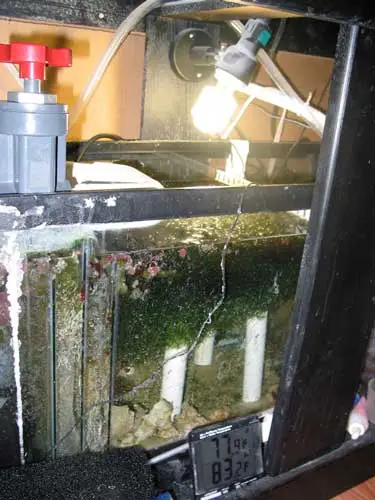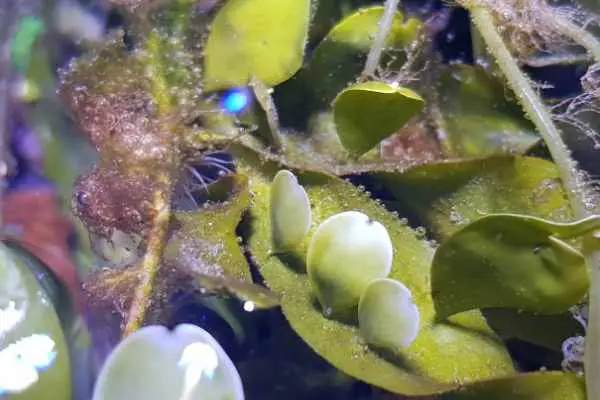ReAs you start to explore the saltwater aquarium hobby, you’ll probably encounter a recommendation to add a refugium to your tank. This simple equipment addition doesn’t seem like much (it doesn’t even take up a ton of real estate), and you may wonder what all the hype’s about. Or you may not even understand why hobbyists rave about having the little micro-ecosystem in their display tanks. Good thing you happened along here to find out what they are – and why you really want to add one to your aquarium.
Table of Contents: Adding Refugiums to Saltwater Aquariums
If you’ve already gained a little insight into refugiums, you may want to skip down to the link below on choosing an appropriate location. Or maybe you’ve never encountered the equipment before. That’s where the entire article will prove the most useful to you. Either way, I’ve laid things out to work for everyone.
- What is a Refugium?
- Top Three Reasons to Add a Refugium
- Picking a Location For Your Refugium
- For More Information

What is a Refugium?
Let’s start with the basics in case you haven’t come across this vital piece of aquarium equipment just yet. A refugium is nothing more than an extra tank added to your aquarium, providing a refuge for primary producers (that would be bacteria, algae, and other plants) and primary consumers (copepods and other tiny crustaceans). Left out in the tank, these crucial food chain members would end up – well, eaten. So the tank protects them and allows them to grow and reproduce. When the populations “overflow,” they escape their home and drift out where they provide a meal for your fish and invertebrates. (And you can harvest the algae when it’s lush and crowding things)
If you want, you can think of the refugium as a nature preserve within the confines of your aquarium system. You’re setting aside a nurturing, PROTECTED sanctuary for the plants and animals inside. And since the tank’s attached to your display tank, the algae and copepods experience the water conditions in your aquarium. That means they absorb and provide the correct balance of nutrients when they eventually turn into fish food.
And if you find yourself with particularly delicate fish or coral species, that protected space works for them, as well. The plexiglass walls shield the animals from aggressive tank mates while they grow, but they still receive the water conditions present in the tank. It’s a handy bit of equipment that saves you from lining your entire house with aquariums (not that I want to stop you from that dream).
Top Three Reasons to Add a Refugium
Now that you understand the reason behind that auxiliary tank, it’s time to look at WHY you might want to add one to your tank. You know, besides the obvious benefit that you won’t need to invest in extra time or money, setting up space to grow algae or nurture copepods. (Unless you WANT to buy these crucial foods all the time) And, of course, we already touched on the fact you won’t have to buy 500 tanks simply to keep and raise the fish and coral you love so much.
No, we’re focusing on the three biggest benefits you’ll receive:
- Removal of nitrates from the water
- Addition of beneficial invertebrates
- Balancing of the water’s pH

Nitrate Removal
One of the biggest concerns aquarists focus on is their water quality. Keeping your water conditions in check tops your list. And one of the biggest helpers in that management is the bacteria and macroalgae you maintain in your tank. Every surface within the tank supports colonies of bacteria. And if you have a deep sand bed, anaerobic bacteria (those that thrive in the absence of oxygen) go to work on removing nitrates from the water.
Well, surprise! The surface of your refugium provides even more room for bacteria to adhere and grow. And, depending on the size of the tank you choose, you can also create a deep sand bed within to encourage those anaerobes to take up residence there. Some hobbyists forgo the look of piles of sand on the bottom of the tank and create a deep bed in their ancillary tank instead. This provides the same benefits without compromising the style of the aquarium they wanted. Meanwhile, the bacteria go to work, scouring those unwanted nitrogen wastes from the water. All from a little extra tank.
And if you allow macroalgae to grow in the refugium, they’ll treat any excess nitrates in the water like plant fertilizer. So the more algae you grow, the more nitrate you will export from your aquarium system. Even better, as the macroalgae remove the nitrates, they strip the “nutrient” away from the microalgae you HATE seeing all over your live rock. Meanwhile, that confined refuge provides a “population control” by limiting the room your algae crop has to grow. The leaves shade themselves, halting growth. Then all you need to do is cut some away, feed it out, and the algae can grow again.
Invertebrate Boost
You’ll find tiny invertebrates (copepods and amphipods for the most part) in most mature saltwater aquariums. They like to hitchhike on live rock, hiding out in the crevices and natural caves. They’re a natural and highly nutritious food source for your fish. That isn’t a problem (it’s a good thing and important for many fish species). The fish in your tank will eat any pods they can catch. However, if you’re trying to prevent your pods from disappearing in a day? You need help.
A refugium provides the perfect oasis for these tasty morsels to grow and reproduce without getting munched. They have a delightful home among the algae (or bouncing around the sand), and they can watch the aquarium activity from the safety of the plexiglass. They also help out your algae by feeding on microscopic pests. That allows the algae to continue growing and removing nitrates. (See how that tiny ecosystem tank functions?)
Because the invertebrates don’t suffer massive predation all the time, their numbers increase. The little additional tank attaches directly to the display tank, so those extra pods make their way into your aquarium and boost the biological activity of your aquarium (and become part of the food chain). You create a normal ecosystem by allowing them to reproduce naturally (which leads to HIGH numbers).

pH Balance
Isn’t there a deodorant with the tagline, “pH balanced for women?” (Sorry, that was a tangent) A refugium won’t help you smell better, but it CAN help the pH balance of your tank. Many people set the light over that extra tank to operate when their display tank is dark. This allows the plants and algae (including symbiotic zooxanthellae in your corals and clams) to turn light and carbon dioxide into sugar, releasing oxygen. And – for those who remember high school chemistry class – the chemical reaction changes the pH in your tank.
If you don’t use opposite lighting schedules, the pH of your tank will vary throughout a 24-hour period as photosynthesis occurs. Using this simple lighting trick can help balance those pH swings, making your tank more stable. And, of course, you’ll boost the growth of the algae within that little tank. That means you get to cycle back around to nitrate removal.
This only works if you have a refugium set up OUTSIDE of your display tank, though. And that brings us to the next important topic: where to place that little tank.
Picking a Location For Your Refugium
Okay, you’re convinced that adding a refugium to your saltwater aquarium makes sense. But now, you need to decide where to add your handy extra tank. You have a couple choices – and neither is better or worse than another. (The important is ADDING that little refuge in the first place) You’ll see three common places to connect a refugium to your aquarium:
- As part of the sump
- An in-tank option
- A HOB
Most aquarists with a sump prefer to dedicate an area within their sump as the refugia. As part of the sump, your refugium connects directly to the aquarium’s existing plumbing, benefiting from the filtration system. You don’t need to pay for anything extra, and the filters keep your algae and pods healthy. It also works best if you want to use the opposing lighting trick. Unfortunately, it’s not a great choice if you happen to forget about the delicate fish fry you’re raising in the tank. Sumps reside UNDER your display tank – out of sight and sometimes out of mind. They can also get pricey, depending on how high-tech and complicated you decide to go.
If you prefer a simple option, in-tank refugium’s fit the bill. What you see is what you get: a small tank that attaches inside your display aquarium. You won’t need to break your bank, purchase extra equipment, or fret that you can’t see how your algae, fry, or pods are doing. Of course, you’re also out of luck if you decide you want a separate lighting schedule. And if you wanted some additional water volume for your tank? Yeah, not so much. But as a little safe haven, it works nicely.
Another popular and easy way to add a refugium to almost any tank is to use a Hang-on-the-back (HOB) style refugium. Similar to HOB filters, they attach to the back of your aquarium. A handy pump then moves water through the tank (and whatever pods feel it’s time to “leave the nest”). You gain additional water volume, and (depending on how you chose to set up your aquarium and stand) you might even be able to puzzle out a way to work on opposing lighting schedules. You WILL find yourself limited on size, considering water’s heavy, and you can’t expect to hang a monster tank from the back. But it’s a nice compromise between the other two options.
For More Information
Refugiums pitch in and make managing a saltwater aquarium a little easier. But if you feel like you need a little more convincing, let’s dive into some extra information. (Or, you know, add some icing to the cake, since you’re probably already placing an order for one)
This YouTube video will walk you through everything you need to know about refugia (and, yes, I promise it’s worth the watch):
Or maybe you’d like to see a refugium in action? This YouTube video focuses on that crucial macroalgae harvest:
Interested in some fish that LOVE copepods? (That should boost your interest in adding one of these tanks!)
Conclusion
Refugiums are a great way to improve the water quality in your aquarium system, and they’re completely natural. They allow you to develop an ecosystem within your tank, providing a balanced food chain. And you’ll end saving money in the long run. You can’t beat that! So, to sum it up, you should add a refugium to your aquarium system if you have the space and money.
Please note: There are affiliate links listed on the page. This means if you click on them (they take you to Amazon’s site) and buy something, a small amount of money is generated for me. I recommend, however, (for a complex purchase like this) that you buy from your preferred aquarium store so you can benefit from the helpful advice and information they can provide.
Written by Albert B. Ulrich III.




Leave a Reply